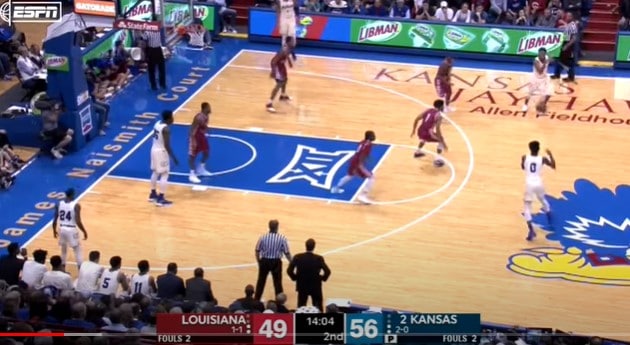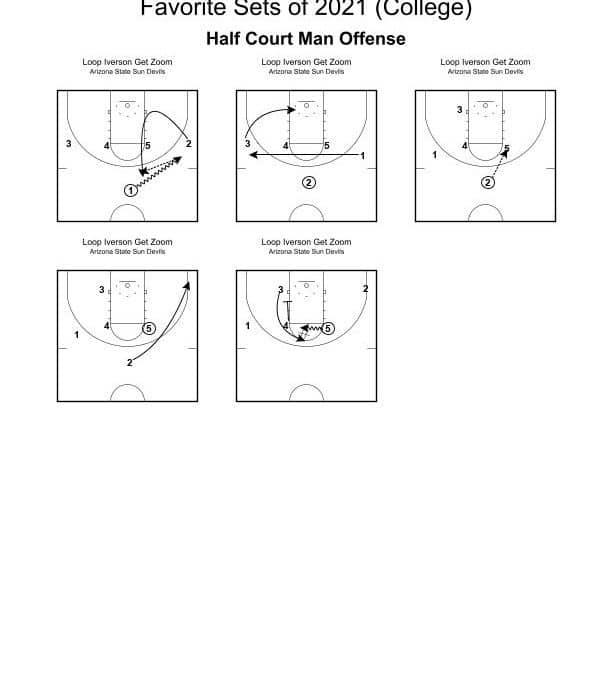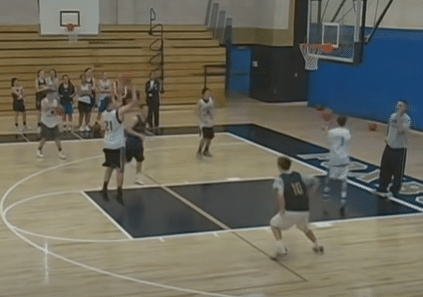Mark Few Man to Man Offensive Concepts
-Started as a high school coach then took a graduate assistant job at Gonzaga for no pay. He was single and could afford to be broke for a couple of years.
-Took over Gonzaga in 1999 and for much of his first 5 years the Zags were a motion/flex team, but as they started receiving national exposure, their recruiting expanded and their talent improved. With the improved talent, they began running more sets and more 2-man game.
-Benchmarks they want to hit (they will post individual’s numbers and the team average in the locker room): 50% FG40% 3PT 75% FT
-They also stress offensive and defensive efficiency with an offensive goal of 1.15 or more points per possession and a defensive goal of limiting the opponents to .9 points per possession or less.
-Offensive Concepts | Mark Few Man to Man Offensive Concepts
1. Attack: Whether it’s coming off the rim or out of the net, they are attacking and getting the ball down the floor as quickly as they can to put pressure on the defense. They want GREAT shots early in the clock. Few firmly believes that an open three early is often as good of a look as you’ll get all possession.
2. Get to the Free Throw Line: The most underrated aspect of offensive basketball as roughly 25% points scored in division 1 basketball are from the free throw stripe. They have 2 goals surrounding this: make more free throws than the other team attempts and to be in the bonus by the 2nd media timeout (8 minutes in)
3. Limit Turnovers: Worst thing you can do offensively is turn it over because it allows you no chance for an offensive rebound or a chance to go to the FT line.
-To stress the importance of taking care of the basketball they will start scrimmaging in practice and have a ball rack on the sideline at practice with x number of balls on it. With each turnover the players commit, the ball is thrown away and they take a new one off the rack. When the rack is empty they stop scrimmaging and run for the remainder of the time.
Ball Screen Offense |Mark Few Man to Man Offensive Concepts
-Requires great spacing, utilizing the corners, and the ball handlers must slow down and read each screen. No two ball screens are the same; you can’t setup a screen thinking “I’m going to turn the corner for a pull-up on this” or “I’m going to split this.” You must read the defense and take what the defense gives you.
-Doesn’t like his guards to split the high hedge because it’s such a high-risk move. Would rather have them “Stockton Pivot” when trapped hard, pivoting off your inside foot and moving your high leg past the guard and throwing a bounce pass to the roll man.
-The Fill Guy is as important as the ball handler or the screener in a ball screen offense. In diagram to the left, 3 is the fill man. As his defender drops to help on 5’s roll, 3 fills up back behind the screen. A good fill forces defenses to be honest with their help. Switch your fill guys as defenses begin to become comfortable with their rotation. A 4 that can shoot in this fill spot is extremely dangerous as the opposing 4 will have fits providing help and getting a hand up. Tells players that if you see the ball going away from you on a ball screen you can’t stand, you’re the fill guy. Move up the court behind the spot where the screen was set.
-Whenever a ball screen is going on one side of the court, the two players on the weakside do not just stand. They will run an exchange or a back screen, some kind of movement to make the helpside defenders think and move. They love an exchange with the corner moving up the court, but making a hard dive to the rim as soon as he gets to the wing.
-Emphasizes a dead sprint to ball screens by his bigs.
-Run 2 different ball screens: Regular (chest to sideline) and Flat (If you guess and show on one side, the big will just pivot to switch the angle and you’re burned).
-Majority of ball screens they run will have the opposite block filled with a post who is stepping in hard in front of his defender as the ball handler is clearing the screen.
-Goal on every ball screen: get a piece of the paint.
-Can only pick and pop when there is an open corner→
Here in this diagram, the big can pop to the corner because there are only 2 people on this side, but on the diagram above, it has to be straight roll because of the 3. 4 would duck in hard as 3 and 1 would replace.
-1st pass of a ball screen is either a catch-and-shoot situation or a quick swinging of the ball. This isn’t a dribble opportunity, it’s either shot or swung.
“Regular”
1 passes to wing and cuts through to ballside corner. 4 screens across for 5 who sprints into ball screen. 2 drives off ball screen as 4 pops to lane line extended and 5 rolls. This is especially dangerous with a shooting 4 man as x4 is stuck with the dilemma of helping on 5’s roll or leaving 4 open.
-Against a hard show | Mark Few Man to Man Offensive Concepts
Offense starts in a 1-4 high set as 1 passes to a wing and rubs off the post for a UCLA cut and proceeds through to weakside. Post who set the back screen steps into a ball screen for wing.
Option 1:
As this is happening, 3, the weakside wing, sprints to set a back screen for 5 after he ball screens.1 quickly passes the ball to 4 who hits 5 streaking to the block for a post-up.
Option 2:
2 and 4 set a stagger for 3 (back screener for 5):
-Move players around to different spots. Test their preparation. If they’ve decided they want to “X” their bigs on ball screens. Put your 4 on the side the ball is being dribbled to off the ball screen. What do they do?
-“Eliminate Help” | Mark Few Man to Man Offensive Concepts
Offense starts in a 1-4 high set with 1 bringing the ball down the middle of the floor. 1 passes to 2 and then receives a double flare from 4 and 3. 2 dribbles off ball screen and passes quickly to 4 who has popped to the top of the key. With the double flare and the 4 popping they’ve eliminated all help for 5’s roll.
-Versus a switch, they will roll a big hard into the post and see if the guard can cover him.
-Versus hard traps, they will screen for the ball screener to make it so the trap is late showing.
-Anytime a big catches the ball up top it is an automatic pass and follow with a ball screen.
-Big component of pregame preparation is “How do they play their ball screens?”
-Big problem with players leaving ball screens too early, before the screen has arrived.
-Begin teaching ball screen actions in 2 person groups before moving to 3 and eventually 4 and 5 players at a time.
Click on the pdf link to download the basketball coaching clinic notes:




0 Comments